Archive:European Neighbourhood Policy - South - tourism statistics
Data extracted in December 2019.
Planned article update: March 2021.
Highlights
There were 1.1 million bed places in hotels and similar accommodation establishments across the European Neighbourhood Policy-South countries (based on the most recent data available), compared with 14.1 million in the EU-28 in 2018.
Among the European Neighbourhood Policy-South countries, non-resident arrivals in hotels and similar accommodation establishments almost quadrupled in Algeria between 2008 and 2018, but fell by more than half in Tunisia between 2008 and 2016.
Among the European Neighbourhood Policy-South countries, 11.0 million outbound trips were taken by tourists from Egypt in 2018, 7.6 million from Israel in 2017 and 5.6 million from Algeria in 2018.
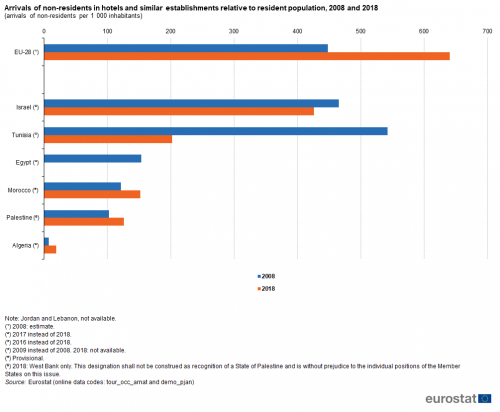
(arrivals of non-residents per 1 000 inhabitants)
Source: Eurostat (tour_occ_arnat) and (tour_cap_nat)
This article is part of an online publication and presents information relating to tourism in the European Union (EU) and eight of the countries that form the European Neighbourhood Policy-South (ENP-South) region — Algeria, Egypt, Israel, Jordan, Lebanon, Morocco, Palestine [1] and Tunisia; no recent data are available for Libya or Syria. It highlights recent developments over the period 2008-2018, with information on capacity (the number of bed places) and international demand (the number of arrivals of non-residents at hotels and similar accommodation) for inbound tourism, as well as information on the number of outbound trips made by tourists.
Full article
Number of bed places
The number of bed places available in hotels and similar accommodation establishments provides one measure of a country’s capacity to attract tourists; note that official tourism statistics include business travellers as tourists alongside individuals travelling for pleasure or other reasons.
The eight ENP-South countries for which data are shown in Table 1 had a combined total of 1.1 million bed places (the latest information relates to 2016, 2017 or 2018). By comparison, there were 14.1 million bed places in hotels and similar accommodation establishments in the EU-28 in 2018.

(thousands)
Source: Eurostat (tour_cap_nat)
Among the ENP-South countries, Morocco (2018 data), Tunisia and Egypt (both 2016 data) had the highest number of bed places in hotels and similar accommodation establishments, with between 202 000 and 261 000 each. In Israel (2017 data), Lebanon (2016 data) and Algeria (2018 data) there were over 100 000 bed places each. The lowest levels of capacity were recorded for Jordan (note the data refer to numbers of rooms) and Palestine, with 30 000 and 16 000 bed places available respectively in 2018 (see Table 1).
Figure 1 provides information on the development of the number of bed places in hotels and similar accommodation establishments over the period 2008-2018. Developments in Egypt were quite regular after an initial increase between 2008 and 2009, as the only other increase recorded thereafter was in 2013, such that overall the total number of bed places was 24 % lower in 2016 than it had been in 2008. Apart from Egypt, the only other ENP-South country to report a fall was Tunisia, where bed capacity was just 1 % lower in 2016 than in 2008. Elsewhere the number of bed places increased between 2008 and 2017 (Israel) or 2018 (elsewhere). In Israel, there was a small decline in bed capacity in the early years of this period, followed by an upswing between 2013 and 2017. In Jordan and Algeria there was a fairly regular, moderate upwards development, while in Palestine and Morocco there were also regular, but stronger increases, as their number of bed places increased by more than two thirds over the period under consideration. Data for Lebanon are incomplete, but show a very large increase in the number of bed places between 2010 and 2011 followed by a relatively stable development through until 2016. For comparison, the number of bed places in hotels and similar accommodation establishments in the EU-28 increased overall by 16 % between 2008 and 2018.
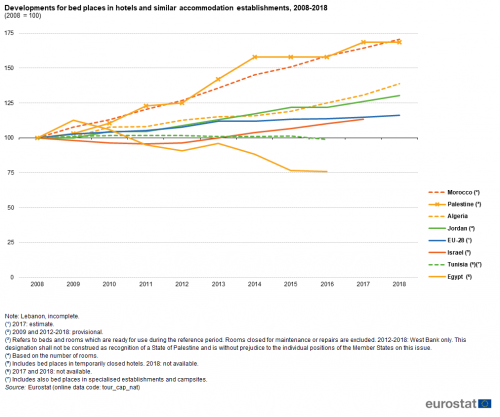
(2008 = 100)
Source: Eurostat (tour_cap_nat)
Figure 2 presents another measure for analysing the number of bed places in hotels and similar establishments, providing information in relation to the size of the national population. The EU-28 recorded a higher capacity of bed places than any of the ENP-South countries, with an average of 28 bed places in hotels and similar accommodation establishments per 1 000 inhabitants in 2018. Tunisia came closest to the EU-28 average, with 21 bed places in hotels and similar accommodation establishments per 1 000 inhabitants in 2016, reflecting the importance of tourism to the Tunisian economy; note that this value includes also bed places in specialised establishments and campsites. In Israel, the capacity of bed places was a little over half the level in the EU-28, while in Morocco it was about one quarter of the EU-28 level. Despite the increase in the number of bed places in all except two (Tunisia and Egypt) of the ENP-South countries in terms of absolute figures, in four countries (Egypt, Jordan, Tunisia and Israel) the capacity of bed places available per 1 000 inhabitants decreased during the period shown in Figure 2, as population growth outstripped any increase in bed places (note again that the data for Jordan refer to the number of rooms).
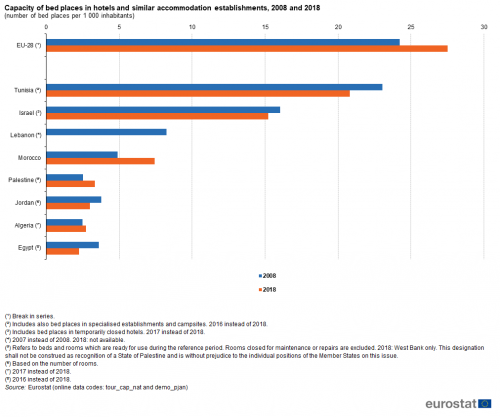
(number of bed places per 1 000 inhabitants)
Source: Eurostat (tour_cap_nat) and (demo_pjan)
Tourist arrivals
The largest number of arrivals of non-residents in hotels and similar accommodation establishments across the ENP-South countries in 2018 or the most recent year (see Table 2 for data availability) was recorded by Egypt, with 7.4 million arrivals in 2014. Morocco had the second largest number of arrivals among ENP-South countries, 5.4 million in 2018, while Israel recorded 3.7 million arrivals in 2017 and Tunisia 2.3 million in 2016. These figures can be compared with a total of 328 million arrivals of non-residents at hotels and similar accommodation establishments in the EU-28 in 2018.

(thousands)
Source: Eurostat (tour_occ_arnat)
Figure 3 shows the development of the number of arrivals of non-residents staying in hotels and similar accommodation establishments during the period 2008-2018. By far the strongest increase (in percentage terms) was recorded for Algeria, where the number of arrivals more than trebled between 2008 and 2018. Although less spectacular, the increase in the number of non-resident arrivals in Palestine was also high, although irregular: in 2018 the number was 57 % higher than it had been in 2008. In Morocco, there was a decline in the number of arrivals between 2008 and 2011 (despite growth in 2010), followed by growth until 2014, a relatively strong subsequent decline through to 2016, and notably stronger growth in 2017 and 2018: the overall change between 2008 and 2018 amounted to an increase of 40 % in the number of arrivals of non-residents. In Israel there was also a slight fall in 2009 and a rebound in 2010, followed by a gentle decline which was reversed in 2016 and 2017 such that the latest figure was 9 % higher than in 2008. In Tunisia, the number of non-resident arrivals fell most years, most notably in 2011 — followed by a rebound in 2012 — and 2015 — again followed by a small rebound in 2016. Although a time series before 2009 is not available for Egypt, the information that is available highlights the impact of political turmoil in recent years: in 2010, the number of non-resident arrivals in Egypt was 12.9 million, but was less than half this level (6.3 million) by 2013, although in 2014 growth returned as the number of arrivals was up to 7.4 million.

(2008 = 100)
Source: Eurostat (tour_occ_arnat)
An alternative analysis is presented in Figure 4: this shows the number of non-resident arrivals in hotels and similar accommodation establishments per bed place. Caution is advised when interpreting these figures: they do not represent occupancy rates, as they do not take into account the length of the stay. Across the EU-28, this ratio averaged 23.3 arrivals of non-residents per bed place in 2018, a level exceeded in 2018 by Palestine and in 2017 by Israel (and by Egypt for which recent data are not available), while the EU-28 average was above the ratios recorded in the three remaining ENP-South countries. This ratio increased in the EU-28 during the period under consideration (2008-2018) as well as in Algeria, while it fell in Israel (2008-2017), Palestine, Morocco and Tunisia (2008-2016).
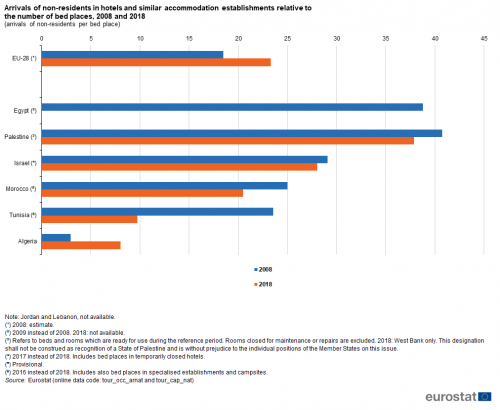
(arrivals of non-residents per bed place)
Source: Eurostat (tour_occ_arnat) and (tour_cap_nat)
Figure 5 shows the number of arrivals of non-residents in hotels and similar accommodation establishments relative to the number of inhabitants. In the EU-28 there were 641 arrivals of non-residents per 1 000 inhabitants in 2018, which marked an overall increase of 43 % when compared with the same ratio for 2008.

(arrivals of non-residents per 1 000 inhabitants)
Source: Eurostat (tour_occ_arnat) and (demo_pjan)
Among the ENP-South countries, the ratio of non-resident arrivals in hotels and similar establishments to population was systematically lower than in the EU-28. The highest values were recorded for Israel (2017 data) and Tunisia (2016 data), with 427 and 202 non-resident arrivals per 1 000 inhabitants respectively. The ratio of non-resident arrivals to the number of inhabitants was around one quarter of the ratio in the EU-28 for Morocco, around one fifth for Palestine, and much lower still in Algeria (2017 data). However, although the ratio remained low, the number of non-resident arrivals relative to population increased in percentage terms at a much faster pace in Algeria (2008-2017) than it did in the EU-28, while the ratio more than halved in Tunisia (2008-2016).
Outbound tourists
This final section details the outward flow of tourists travelling abroad. There were 284 million trips made by EU-28 tourists to destinations outside of their own Member State in 2017; note that EU-28 data for this particular indicator only refer to persons aged 15 and over and do not include data for the United Kingdom.
Among the ENP-South countries for which data are available, the highest number of outbound trips taken by tourists was recorded for Egypt at 11.0 million in 2018, while there were 7.6 million outbound trips made by tourists from Israel in 2017, ahead of Algeria with 5.6 million in 2018 (see Table 3).
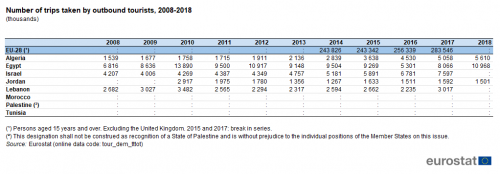
(thousands)
Source: Eurostat (tour_dem_tttot)
Developments for the number of outbound tourist trips between 2008 and 2018 are shown in Figure 6. Algeria recorded the strongest overall growth, with its number of outbound tourist trips more than trebling during this 10-year period. In Israel the number of trips increased overall by 81 % between 2008 and 2017. For Egypt and Lebanon the developments were less regular. The number of trips taken from Egypt in 2018 was 61 % higher than in 2008 after an uneven development, notably a large fall in the number of trips taken in 2016 and a strong rebound in 2017 and 2018. Lebanon also recorded a strong fall in outbound trips in 2016 and a rebound in 2017 such that the figure in 2017 was 13 % higher than in 2008. For Jordan the time series start in 2010 and the number of outbound trips fell strongly through until 2014 before recovering somewhat in 2015 and then stabilising at about half the peak level of 2010.
Figure 7 presents the number of outbound trips taken by tourists relative to the size of the population. In the EU-28 there were, on average, 636 trips per 1 000 inhabitants in 2017; note that these figures for tourist trips relate to persons aged 15 and over while the ratio is calculated relative to the total population and the indicator does not include data for the United Kingdom.
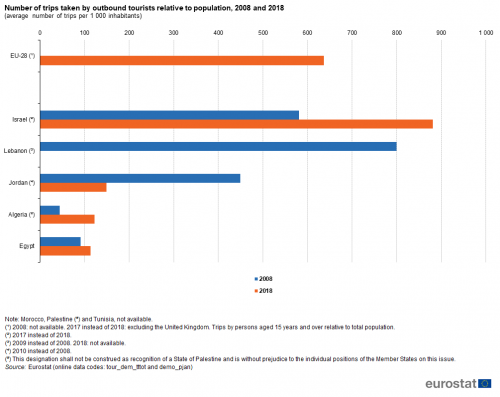
(average number of trips per 1 000 inhabitants)
Source: Eurostat (tour_dem_tttot) and (demo_pjan)
Among the ENP-South countries, Israel recorded the highest ratio of outbound trips relative to population size, at 880 trips per 1 000 inhabitants in 2017 and was the only ENP-South country (for which recent data are available) to record a ratio above the EU-28 average; note that older data also show a relatively high ratio for Lebanon. The second highest ratio in recent years was 149 trips per 1 000 inhabitants for Jordan in 2018, ahead of Algeria (2017 data) and Egypt: all three of these countries’ ratios were less than one quarter of the EU-28 average.
Source data for tables and graphs
Data sources
Tourism, in a statistical context, refers to the activity of visitors taking a trip to a destination outside their usual environment, for less than a year. It can be for any main purpose, including business, leisure or other personal reasons other than to be employed in the place visited. A tourist is a visitor that stays overnight (at least one night).
Within the EU, a system of tourism statistics was established through Council Directive 95/57/EC of 23 November 1995 on the collection of statistical information in the field of tourism. This legal basis requires EU Member States to provide a regular set of comparable tourism statistics. Following amendments in 2004 and 2006, the European Parliament and the Council of the European Union adopted Regulation (EU) No 692/2011 concerning European statistics on tourism in 2011 (repealing Council Directive 95/57/EC).
Tourism statistics in the EU consist of two main components: on the one hand, statistics relating to capacity and occupancy (supply side tourism statistics); on the other, statistics relating to tourism demand. In most EU Member States, the former are collected via surveys filled in by accommodation establishments, while the latter are mainly collected via traveller surveys at border crossings or through household surveys. Statistics on tourism demand refer to tourist participation, in other words, trips of at least one overnight stay during the reference period.
The data for ENP-South countries are supplied by and under the responsibility of the national statistical authorities of each country on a voluntary basis. The data that are presented in this article result from an annual data collection cycle that has been established by Eurostat. No recent data are available from either Libya or Syria. These statistics are available free-of-charge on Eurostat’s website, together with a range of different indicators covering most socio-economic areas.
Tables in this article use the following notation:
| Value in italics | data value is forecasted, provisional or estimated and is therefore likely to change; |
| : | not available, confidential or unreliable value; |
| – | not applicable. |
Context
Tourism has the potential to contribute towards employment and economic growth, as well as to development in rural, peripheral or less-developed areas. Infrastructure created for tourism purposes contributes to local development, while jobs that are created or maintained can help counteract industrial or rural decline. Sustainable tourism involves the preservation and enhancement of cultural and natural heritage, ranging from the arts to local gastronomy or the preservation of biodiversity.
On 18 November 2015, the High Representative for Foreign Affairs and Security Policy and the European Commission jointly presented a review of the European Neighbourhood Policy (SWD(2015) 500 final) which underlined a new approach for the EU in relation to its eastern and southern neighbours, based on stabilising the region in political, economic, and security-related terms.
In cooperation with its ENP partners, Eurostat has the responsibility ‘to promote and implement the use of European and internationally recognised standards and methodology for the production of statistics necessary for developing and monitoring policy achievements in all policy areas’. Eurostat undertakes the task of coordinating EU efforts to increase the statistical capacity of the ENP countries. Additional information on the policy context of the ENP is provided here.
Notes
- ↑ This designation shall not be construed as recognition of a State of Palestine and is without prejudice to the individual positions of the Member States on this issue.
Direct access to
Books
Leaflets
- Basic figures on the European Neighbourhood Policy — South countries — 2019 edition
- Basic figures on the European Neighbourhood Policy — South countries — 2018 edition
- Basic figures on the European Neighbourhood Policy — South countries — 2016 edition
- Basic figures on the European Neighbourhood Policy — South countries — 2015 edition
- Tourism statistics for the European Neighbourhood Policy — South countries — 2019 edition
- Tourism (med_to)
- Main flows (med_to11)
- Arrivals by type of accommodation (med_to12)
- Nights spent by type of accommodation (med_to13)
- Accommodation establishments (med_to21)
- Number of bed-places (med_to22)
- Tourism (tour), see:
- Monthly data on tourism industries (tour_indm)
- Annual data on tourism industries (tour_inda)
- Annual data on trips of EU residents (tour_dem)
- Southern European Neighbourhood Policy countries (ENP-South) (med) (ESMS metadata file — med_esms)
- Annual data on trips of EU residents (ESMS metadata file — tour_dem_esms)
- Occupancy of tourist accommodation establishments (ESMS metadata file — tour_occ_esms)
- Methodological manual for tourism statistics — Version 2.1 — 2013 edition
